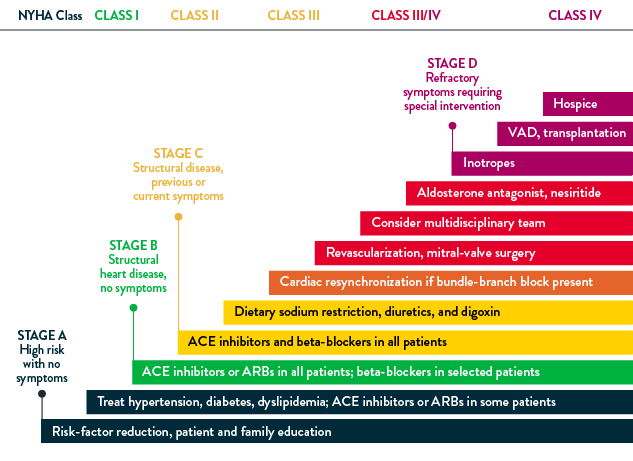Recognizing the Stages of Heart Failure
Stages of heart failure1

The New York Heart Association (NYHA) classifies the stages of heart failure as follows:2
No limitation of physical activity. Ordinary physical activity does not cause undue fatigue, palpitation, dyspnea (shortness of breath).

Slight limitation of physical activity. Comfortable at rest. Ordinary physical activity results in fatigue, palpitation, dyspnea (shortness of breath).

Marked limitation of physical activity. Comfortable at rest. Less than ordinary activity causes fatigue, palpitation or dyspnea.

Unable to carry on any physical activity without discomfort. Symptoms of heart failure at rest. If any physical activity is undertaken, discomfort increases.

The American College of Cardiology/American Heart Association categorize the development and progression of heart failure into 4 stages: A through D.1,3
Stage A
Patients at high risk of developing heart failure who are asymptomatic and have no identified structural or functional cardiac abnormalities.
Stage B
Patients with structural heart disease associated with the development of heart failure but who are asymptomatic.
Stage C
Patients who have current or prior symptoms of heart failure associated with underlying structural disease.
Stage D
Patients with advanced structural heart disease and marked symptoms of heart failure at rest despite optimal medical management and who require specialized interventions.
Common symptoms of the advanced heart failure patient4
- Dyspnea
- Right ventricular failure
- Fatigue
- Edema
- Abdominal distention
- Sleep disturbances
- Intolerance to previously tolerated doses of ACE inhibitors and beta blockers
- Escalating diuretics with persistent congestion
This device is commercially available for use in select international markets.
References
- Jessup M, Brozena S. Heart failure. N Engl J Med. 2003;348:2007-2018.
- https://www.heart.org/en/health-topics/heart-failure/what-is-heart-failure/classes-of-heart-failure. Accessed on Dec. 10, 2020.
- Hunt SA, Baker DW, Chin MH, et al. ACC/AHA Guidelines for the Evaluation and Management of Chronic Heart Failure in the Adult: Executive Summary. A report of the American College of Cardiology/American Heart Association Task Force on Practice Guidelines (Committee to Revise the 1995 Guidelines for the Evaluation and Management of Heart Failure). Circulation. 2001;104:2996-3007.
- AbouEzzeddine OF, Redfield MM. Who has advanced heart failure? Definition and epidemiology. Congest Heart Fail. 2011;17:1-18.
MAT-2105170 v3.0
